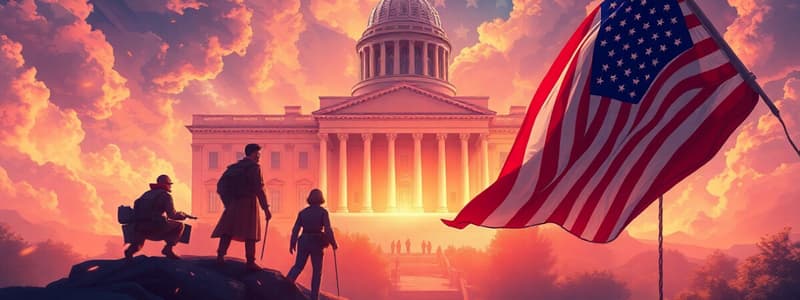Podcast
Questions and Answers
Which action exemplifies the President acting as Chief Diplomat?
Which action exemplifies the President acting as Chief Diplomat?
- Requesting Congress to draft legislation on economic policy.
- Directing the Secretary of Defense to develop new military strategies.
- Appointing a new ambassador to represent the U.S. in another country.
- Negotiating a nuclear arms treaty with a foreign nation. (correct)
What is the significance of the Supreme Court's ruling in Marbury v. Madison?
What is the significance of the Supreme Court's ruling in Marbury v. Madison?
- It established the power of judicial review, allowing the Supreme Court to declare laws unconstitutional. (correct)
- It established the principle of executive privilege.
- It outlined the process for presidential impeachment.
- It defined the powers of the legislative branch concerning foreign policy.
Which of the following scenarios represents a check on the power of the executive branch?
Which of the following scenarios represents a check on the power of the executive branch?
- The Senate rejects the President's nominee for Secretary of State. (correct)
- The Supreme Court declares a law passed by Congress as unconstitutional.
- The President vetoes a bill passed by Congress.
- The President issues an executive order.
What role does the President fulfill when asking their cabinet to propose and support legislation?
What role does the President fulfill when asking their cabinet to propose and support legislation?
Which of the following actions demonstrates the system of checks and balances?
Which of the following actions demonstrates the system of checks and balances?
What is the purpose of the President’s 'State of the Union' address?
What is the purpose of the President’s 'State of the Union' address?
Which branch of the U.S. government is responsible for approving treaties negotiated by the President?
Which branch of the U.S. government is responsible for approving treaties negotiated by the President?
If the President commits a crime, which body has the power to impeach (bring charges against) the President?
If the President commits a crime, which body has the power to impeach (bring charges against) the President?
Which of the following is an example of the President acting in their role as Commander-in-Chief?
Which of the following is an example of the President acting in their role as Commander-in-Chief?
Which of the following describes the role of the judicial branch?
Which of the following describes the role of the judicial branch?
How does the legislative branch check the power of the judicial branch?
How does the legislative branch check the power of the judicial branch?
Which scenario best illustrates the principle of checks and balances in action?
Which scenario best illustrates the principle of checks and balances in action?
What was the effect of the Marbury vs. Madison Supreme Court case?
What was the effect of the Marbury vs. Madison Supreme Court case?
Which activity falls within the responsibilities of the Legislative Branch?
Which activity falls within the responsibilities of the Legislative Branch?
How can Congress respond if the President vetoes a bill they believe is necessary?
How can Congress respond if the President vetoes a bill they believe is necessary?
Flashcards
Legislative Branch
Legislative Branch
Congress; made up of the House of Representatives and Senate, proposing, writing, and voting on laws, and approving treaties.
Executive Branch
Executive Branch
The U.S. President and their cabinet.
Chief Legislator
Chief Legislator
The President's role in asking executive departments to propose and support legislation.
Chief Executive
Chief Executive
Signup and view all the flashcards
Chief Diplomat
Chief Diplomat
Signup and view all the flashcards
Judicial Branch
Judicial Branch
Signup and view all the flashcards
Marbury vs. Madison
Marbury vs. Madison
Signup and view all the flashcards
Checks and Balances
Checks and Balances
Signup and view all the flashcards
Impeachment
Impeachment
Signup and view all the flashcards
Veto and Override
Veto and Override
Signup and view all the flashcards
Treaty Ratification
Treaty Ratification
Signup and view all the flashcards
Judicial Review
Judicial Review
Signup and view all the flashcards
Judicial Appointments
Judicial Appointments
Signup and view all the flashcards
Study Notes
- The legislative branch, also known as Congress, comprises the House of Representatives and the Senate.
- Congress consists of representatives from each state.
- Congress proposes, writes, and votes on laws.
- Congress approves treaties.
- The executive branch includes the U.S. President and their cabinet.
- The president's role as Chief Legislator involves tasking executive department staff with proposing and supporting legislation.
- The president, as Chief Executive, is the highest military official and commander-in-chief.
- Serving as Chief Diplomat, the president meets and negotiates with foreign leaders.
- Examples of presidential diplomacy include Wilson at the Treaty of Versailles, Reagan meeting Gorbachev, and Jimmy Carter negotiating the Camp David Accords.
- The president must periodically inform Congress and the nation about the state of the union, which refers to the condition of the country.
- The judicial branch consists of federal courts and the Supreme Court.
Marbury v. Madison
- The Marbury v. Madison case was heard under Chief Justice John Marshall.
- It established judicial review.
- The case strengthened the judicial branch (Supreme Court).
- This was the first time a federal law was declared unconstitutional by the Supreme Court.
Checks and Balances
- Checks and balances are in place to ensure that no single branch of government has excessive power.
- The president can be impeached and removed from office by Congress through a trial.
- When Congress passes a bill, the president can either sign it into law or veto it.
- Congress can override a presidential veto with a 2/3 vote of both houses.
- The president can negotiate treaties, but the Senate must ratify them.
- The Supreme Court can rule that a law is unconstitutional.
- The president appoints Supreme Court judges, but the Senate must approve these appointments.
Studying That Suits You
Use AI to generate personalized quizzes and flashcards to suit your learning preferences.



